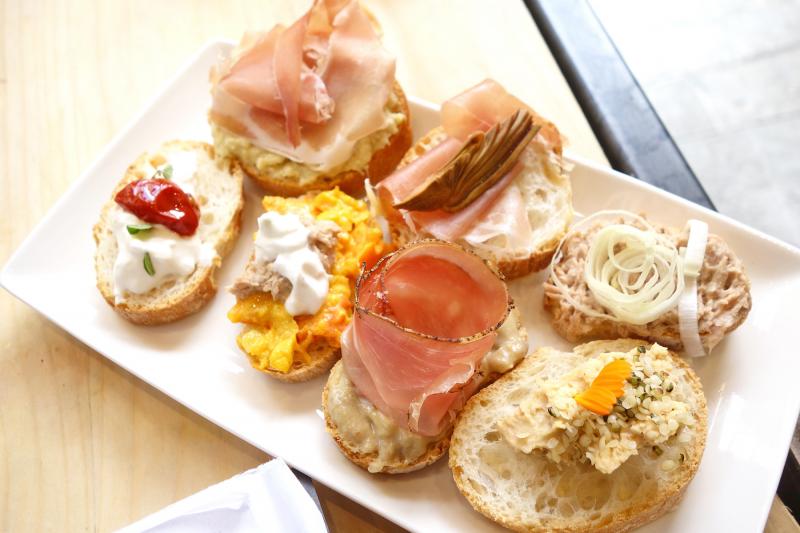Rick Steves’ Europe: Venice’s cicchetti crawl
Appears in the Online Edition, August 2021.
One of my favorite European memories is the joy of a pub crawl in Venice — a reminder of the fun that awaits in this popular destination.
Venice entertains millions of visitors during a normal year. It’s particularly crowded with day-trippers when several cruise ships are in port. On a trip a few years ago, I was told by a Venetian friend that these days, almost every restaurant caters to the tourists. Then, with a sly smile, he added, “But there are still the cicchetti bars.”
Cicchetti (pronounced chi-KET-tee) are the local appetizers that line the counters of little pubs all over Venice at the end of each workday. My favorite meal is what I call “The Stand-Up Progressive Venetian Pub-Crawl Dinner.” In a town with canals and no cars, pub-crawling is easy and safe — perhaps safer if you know how to swim. Tonight I’ll visit a series of these characteristic hole-in-the-wall pubs, eating ugly-looking morsels on toothpicks and washing it all down with little glasses of wine. I look forward to the local characters I’ll meet along the way. Cicchetti bars have a social stand-up zone with a cozy gaggle of tables. In some of the more popular places, the crowds spill happily into the street.
Venetians call this pub crawl the giro d’ombra. Giro means “stroll,” and ombra — slang for a glass of wine — means “shade.” It dates back to the old days, when a portable wine bar scooted with the shadow of the Campanile bell tower across St. Mark’s Square. That wine bar is long gone, but the cicchetti bars remain, tucked away in the perpetual shade of the back streets.
While Venice is, it seems, sinking in tourist crowds, I’d bet 90 percent of those tourists gather along the glitzy shopping streets between the Rialto Bridge and St. Mark’s Square. To find a characteristic cicchetti bar, you have to wander. I don’t worry about getting lost — in fact, I get as lost as I can. I remind myself, “I’m on an island and I can’t get off.” Even though there generally aren’t street names, when I want to find my way, I simply look for small signs on the corners directing me to the nearest landmark (e.g., “per Rialto”).
The cicchetti selection is best early, so I start my evening at 6 p.m. It’s in the far reaches of Venice that I bump into the thriving little bacari (as the local pubs are called). I ask for “un piatto classico di cicchetti misti da otto euro” and get a classic plate of assorted appetizers for €8. I sample deep-fried mozzarella cheese, gorgonzola, calamari, and artichoke hearts. Crostini (small pieces of toasted bread with a topping) are also a favorite, as are marinated seafood, olives, and prosciutto with melon. Meat and fish (pesce) munchies can be expensive, but veggies (verdure) are cheap. Bread sticks (grissini) are free for the asking.
Part of the attraction is the funky decor. There are photos of neighborhood friends here for a family party, St. Mark’s Square the morning after a wild Pink Floyd concert, Carnevale masks evoking a more mysterious past, and of old-time Venice, proving that people may change, but the buildings remain essentially the same.
Venetians kick off the experience with an aperitivo, a before-dinner drink. Know your options. A blackboard usually lists several fine wines that are uncorked and available by the glass. Most nights, I get a small glass of house red or white wine (ombra rosso or ombra bianco). Tonight, I’m in the mood for an Aperol spritz — it makes me feel more local.
A man asks me, “Le dispiace se mi siedo qui?” (Do you mind if I sit here?) before sitting down next to me. It occurs to me that’s a handy, polite phrase for making new friends. He orders a drink and food. When his plate of fish arrives, he picks up one of the tiny fish, delicately tied in a loop. Holding it by the toothpick that harpoons it, he looks at it lovingly, says, “Sei il mio piu bel ricordo” (“You are my most beautiful souvenir”), and pops it happily into his mouth. Pushing over his plate, he offers one of the fish to me.
Connecting with people makes a pub crawl more fun: You can meet an Italian, learn some Italian, eat better ... and collect your own beautiful souvenirs.
(Rick Steves (www.ricksteves.com) writes European guidebooks, hosts travel shows on public TV and radio, and organizes European tours. This article was adapted from his new book, For the Love of Europe. You can email Rick at rick@ricksteves.com and follow his blog on Facebook.)

